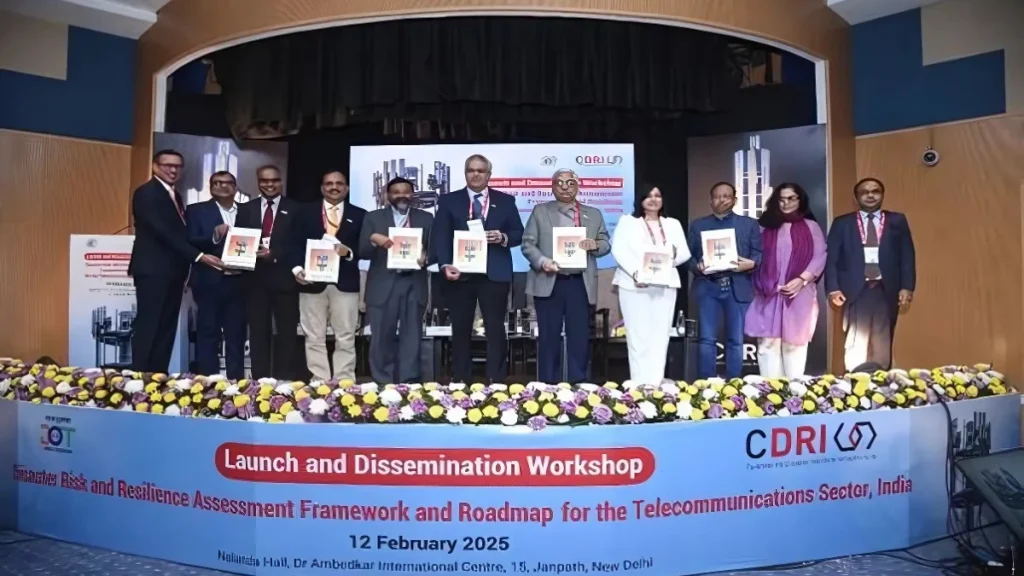The Department of Telecommunications (DoT), in partnership with the Coalition for Disaster Resilient Infrastructure (CDRI), has launched the Disaster Risk and Resilience Assessment Framework (DRRAF) to enhance disaster preparedness in India’s telecom sector. This initiative is part of a comprehensive study on disaster risk assessment for telecommunications, covering five states: Assam, Odisha, Tamil Nadu, Uttarakhand, and Gujarat.
The study examined disaster risks, resilience strategies, and vulnerabilities within the telecom sector. DoT coordinated efforts with State Governments, Telecom Service Providers (TSPs), and Infrastructure Providers to facilitate data collection and analysis.
Strengthening Telecom Resilience
Dr. Neeraj Mittal, Secretary (Telecom) and Chairman of the Digital Communications Commission (DCC), underscored the national priority of building telecom resilience. He highlighted DoT’s commitment to ensuring uninterrupted connectivity during disasters in alignment with the UN’s ‘Early Warning For All by 2027’ initiative.
Manish Sinha, Member (F), DoT, stressed the crucial role of telecom networks in disaster response and highlighted the study’s roadmap for minimising service disruptions and improving emergency response mechanisms.
Shri Sanjay Agrawal, DDG (DM), DoT, acknowledged the collaboration of telecom stakeholders, including Local Service Areas (LSAs), TSPs, Infrastructure Providers, and industry bodies such as the Digital Infrastructure Providers Association (DIPA), Cellular Operators Association of India (COAI), and Indian Broadcasting Foundation (IBF). He emphasised that practical implementation of the study’s recommendations would enhance telecom resilience.
Key Insights and Recommendations
The study assessed risks across 0.77 million telecom towers, mapping threats from floods, cyclones, and earthquakes. It introduced a disaster risk and resilience index to evaluate telecom infrastructure vulnerability based on disaster intensity and frequency.
The framework outlines strategic recommendations to strengthen the sector’s preparedness:
- Enhancing telecom infrastructure design to withstand disasters.
- Establishing a multi-hazard information repository for data-driven risk management.
- Integrating risk-informed governance into telecom policies.
- Developing financial risk-sharing mechanisms for telecom operators.
- Creating a cross-sectoral collaboration framework for coordinated disaster response.
- Strengthening financial strategies to support resilient infrastructure.
- Expanding last-mile connectivity to ensure accessibility during emergencies.
- Leveraging digital solutions to improve crisis response and service restoration.
- Increasing institutional capacity and training for emergency preparedness.
- Implementing monitoring systems to enhance service reliability.
DoT’s Disaster Preparedness Initiatives
DoT has been actively working on disaster resilience through:
- Real-time coordination with LSAs, State Governments, and telecom operators.
- Nationwide implementation of a Cell Broadcast System for emergency alerts.
- Deployment of Public Protection and Disaster Relief (PPDR) networks with the Ministry of Home Affairs.
- Strengthening regulatory frameworks for faster service restoration.
- Promoting satellite communication and High Altitude Platform Systems (HAPS) to maintain connectivity in disaster-affected regions.
Advancing Resilience in Telecom Infrastructure
CDRI Director General Amit Prothi highlighted the telecom sector’s critical role in economic growth and disaster response. The study offers a scalable model and global best practices to enhance resilience in communication services.
With this framework, CDRI and DoT aim to integrate resilience principles into telecom policy and planning, ensuring India’s telecom infrastructure can effectively withstand and recover from disasters. The collaborative approach seeks to establish robust and uninterrupted communication networks nationwide.


